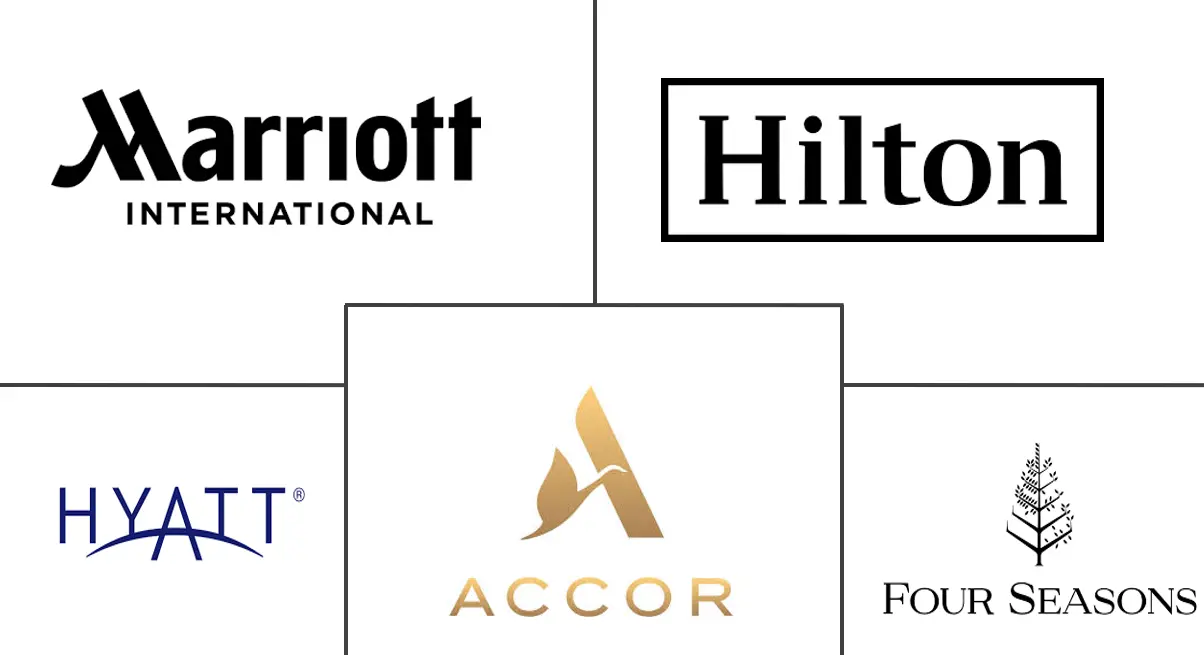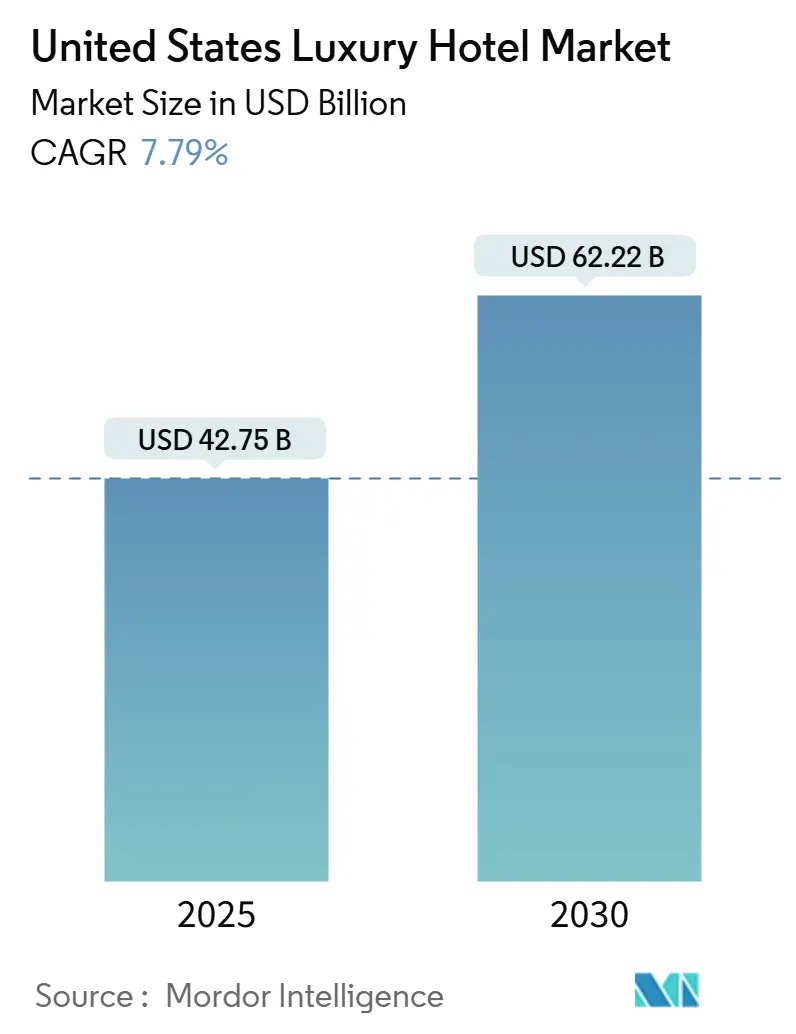
United States Luxury Hotel Market Analysis by Mordor Intelligence
The United States Luxury Hotel Market size is estimated at USD 42.75 billion in 2025, and is expected to reach USD 62.22 billion by 2030, at a CAGR of 7.79% during the forecast period (2025-2030).
Persistent demand from ultra-high-net-worth travelers, growing millennial affluence, and expanding corporate bleisure policies continue to reinforce pricing power and length‐of‐stay metrics. Direct digital distribution strategies, the proliferation of mixed-use hotel–residence assets, and the recovery of international inbound arrivals further underpin revenue growth prospects. Meanwhile, operators face countervailing pressures from labor scarcity, rising insurance premiums, and intensifying competition from professionally managed luxury vacation rentals. The ability to balance cost containment, service personalization, and ESG compliance will shape competitive positions as the United States luxury hotel market advances toward its next growth cycle.
Key Report Takeaways
- By room type, suites captured 43.36% of United States luxury hotel market share in 2024; villas and bungalows are projected to expand at a 7.88% CAGR through 2030.
- By booking channel, direct booking accounted for 50.76% of the United States luxury hotel market size in 2024 and are advancing at a 10.29% CAGR to 2030.
- By service type, resorts held 36.26% of United States luxury hotel market share in 2024; suite hotels represent the fastest-growing service category with an 8.24% CAGR to 2030.
- By geography, the South commanded 31.74% of United States luxury hotel market share in 2024; the West is forecast to grow at a 7.87% CAGR through 2030.
United States Luxury Hotel Market Trends and Insights
Drivers Impact Analysis
| Driver | (~) % Impact on CAGR Forecast | Geographic Relevance | Impact Timeline |
|---|---|---|---|
| Surge in UHNW & millennial wealth fueling experiential luxury demand | +2.1% | Northeast, West core markets, spillover to South | Medium term (2-4 years) |
| Resurgent inbound travel to U.S. gateway cities post-visa easing | +1.8% | Northeast, West gateway cities, secondary spillover | Short term (≤ 2 years) |
| Corporate bleisure policies boosting long-stay luxury room nights | +1.4% | National, early gains in major business centers | Medium term (2-4 years) |
| Shift toward direct digital bookings lowering distribution costs | +1.2% | National, technology-forward urban markets | Short term (≤ 2 years) |
| Expansion of mixed-use hotel-residence projects stabilizing RevPAR | +0.9% | West, Northeast prime urban cores | Long term (≥ 4 years) |
| ESG incentives for LEED-certified assets lifting ADR premiums | +0.6% | National, regulatory emphasis in California, Northeast | Long term (≥ 4 years) |
| Source: Mordor Intelligence | |||
Surge in UHNW & Millennial Wealth Fueling Experiential Luxury Demand
Global ultra-high-net-worth individuals surpassed 625,000 in 2023, controlling USD 30 trillion in wealth and registering 4% annual growth[1]Mastercard Data & Services, “Understanding Ultra-High-Net-Worth Customers,” mastercardservices.com. . Their preference for wellness, privacy, and cultural immersion is converging with millennial spending power, which prioritizes authentic experiences over material acquisitions. Luxury travelers under age 60 now dominate premium demand, and multigenerational itineraries are becoming commonplace. Operators respond with curated wellness programs, local art partnerships, and sustainability initiatives that resonate with values-driven guests. These enhancements enable higher average daily rates while supporting extended stays, thereby improving RevPAR resiliency. The trend reinforces the experiential essence of the United States luxury hotel market and sustains its premium pricing trajectory.
Resurgent Inbound Travel to U.S. Gateway Cities Post-Visa Easing
International arrivals rebounded to 72.4 million in 2024 and are forecast to reach 77.1 million in 2025 as visa processing accelerates and flight capacity normalizes[2]U.S. International Trade Administration, “Total International Travel Volume,” trade.gov. . New York, Los Angeles, and Miami are already posting visitor volumes approaching 2019 baselines, generating tangible upticks in luxury ADRs. Growth in inbound traffic from India and the Dominican Republic offsets lingering softness from some Western European markets. Because international visitors typically book longer itineraries and spend more per capita, luxury properties in gateway cities capture outsized benefits. Hotels that offer multilingual staff, culturally tailored F&B programs, and curated destination content are especially well-positioned. This macro tailwind provides additional momentum for the United States luxury hotel market through mid-decade.
Corporate Bleisure Policies Boosting Long-Stay Luxury Room Nights
Sixty-two percent of U.S. business travelers blended work and leisure in 2024, while 42% appended personal days to corporate trips, underscoring the bleisure paradigm shift. Team-building and incentive events now represent a structurally larger share of corporate travel budgets, and the sector is projected to reach USD 1.4 trillion in 2024. Luxury hotels are adapting with flexible workspace suites, high-bandwidth connectivity, and wellness-oriented breakouts that align with employee retention goals. Extended-stay packages drive length-of-stay metrics, thereby improving occupancy and ancillary F&B revenue. This dynamic supports steady demand even when transient corporate volumes fluctuate. Ultimately, bleisure reinforces the experiential ethos of the United States luxury hotel market, deepening customer loyalty.
Shift Toward Direct Digital Bookings Lowering Distribution Costs
Direct digital channels surpassed 50% of luxury hotel room nights in 2024 and are projected to contribute USD 409 billion globally by 2030[3]Skift, “Hotel Distribution to 2030,” hospitalitynet.org.. Mobile bookings already approach one-third of all brand-website transactions, aided by AI-driven recommendation engines that enhance conversion. For luxury operators, reducing reliance on OTAs cuts 15–25% commission outflows while delivering rich first-party data. Enhanced loyalty integration further personalizes offers and amplifies repeat visitation. The margin uplift supports reinvestment in guest experience innovations, augmenting competitiveness across the United States luxury hotel market.
Restraints Impact Analysis
| Restraint | (~) % Impact on CAGR Forecast | Geographic Relevance | Impact Timeline |
|---|---|---|---|
| Competition from ultra-luxury vacation rentals & branded residences | −1.6% | National, leisure destinations concentrated | Medium term (2-4 years) |
| Persistent labor shortages raising payroll costs | −1.3% | National, acute in high-cost urban markets | Short term (≤ 2 years) |
| Rising insurance premiums linked to climate-driven weather events | −0.8% | South, West coastal markets | Long term (≥ 4 years) |
| Rate fatigue among domestic travelers amid inflation pressures | −0.7% | National, secondary markets sensitive | Short term (≤ 2 years) |
| Source: Mordor Intelligence | |||
Competition from Ultra-Luxury Vacation Rentals & Branded Residences
Demand for vacation rentals priced above USD 1,000 per night has risen 73% since 2019, mirroring affluent travelers’ desire for privacy and personalized local immersion. Professional operators such as Wander and Mint House now deliver hotel-level amenities within residential settings, eroding share in high-end leisure destinations. Luxury hotels are countering with villa clusters, dedicated butler teams, and partnerships with experiential tour providers; however, structural limitations make rival offerings difficult to replicate. Competitive pressure is most acute in coastal and mountain resort markets, where the villa inventory is deep. The United States luxury hotel market must therefore innovate around exclusivity and authenticity to preserve share.
Persistent Labor Shortages Raising Payroll Costs
Seventy-nine percent of U.S. hotels reported unfilled positions in 2024, and total payroll expenses rose 11.9% year-over-year[4]Hospitality Net, “Staffing Crisis in U.S. Hotels,” hospitalitynet.org.. Luxury properties feel the impact disproportionately because elevated service standards require higher staffing ratios and specialized skills. Average hourly wages climbed to USD 23.91 in December 2023, and premium brands often pay 20–30% above that benchmark. Automation mitigates some back-of-house functions, but face-to-face service remains core to luxury value propositions. Consequently, labor scarcity continues to constrain margin expansion despite buoyant top-line growth in the United States luxury hotel market.
Segment Analysis
By Room Type: Suites Anchor Extended-Stay Positioning
Suites captured 43.36% of United States luxury hotel market share in 2024, reflecting the enduring appeal of residential-style layouts that enable bleisure and multigenerational stays. Standard luxury rooms maintained 35% share by catering to travelers who prioritize brand assurance and central locations. Villas and bungalows, although smaller in installed base, are advancing at a 7.88% CAGR as affluent guests seek heightened privacy and experiential latitude. Penthouses and presidential suites—just 6% of room inventory—command nightly rates that can exceed USD 10,000 in gateway cities, contributing disproportionate ADR lift. The segment mix underscores a shift toward spatial flexibility, wellness integration, and in-room technology that support work-from-anywhere behavior. Operators are redesigning legacy suite layouts to incorporate fitness corners, modular furnishings, and pantry-stocking services that mirror private residences. This evolution enhances pricing power and length-of-stay resilience across the United States luxury hotel market.
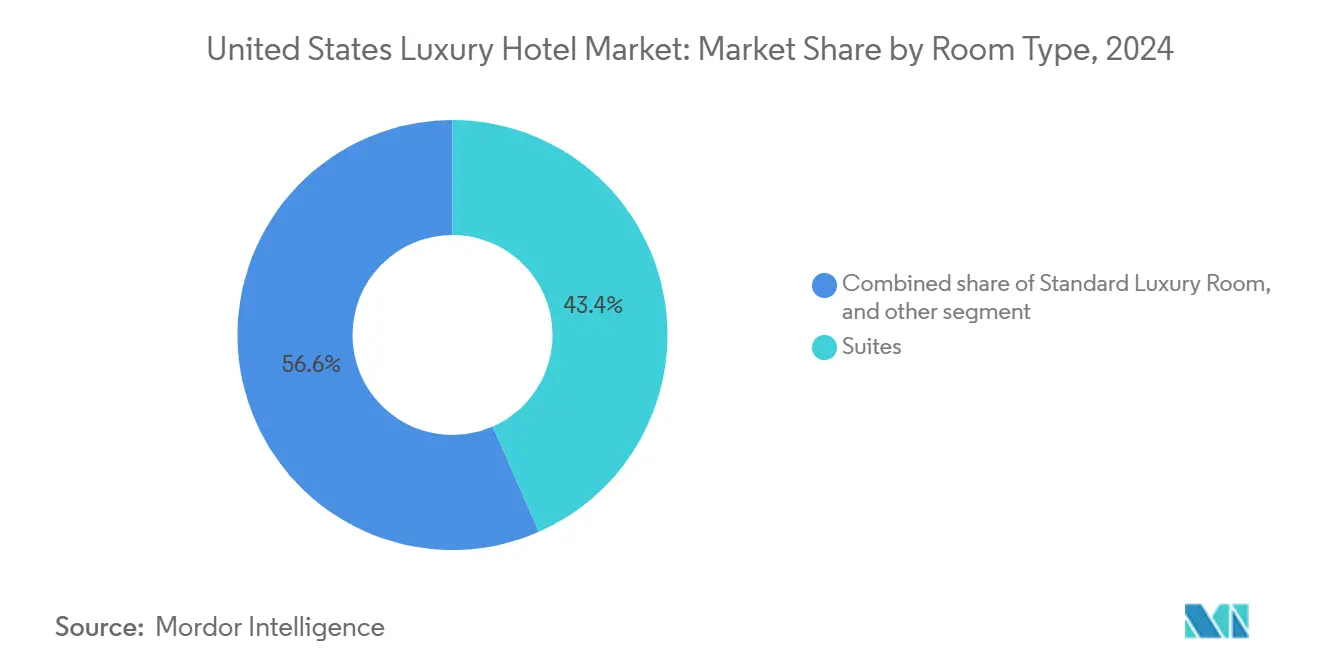
Note: Segment shares of all individual segments available upon report purchase
By Booking Channel: Direct Digital Command
Direct booking from brand websites and mobile apps generated 50.76% of bookings in 2024, growing at a 10.29% CAGR as loyalty enrollments and dynamic pricing tools mature. OTAs, once dominant, now hold 27% share but retain relevance for last-minute leisure demand and opaque promotion funnels. Travel agents and tour operators account for 14% of room nights, particularly for complex luxury itineraries that require bespoke curation. Corporate negotiated contracts represent the remaining 7%, supporting volume stability in primary business hubs. Mobile transaction penetration is climbing rapidly, with 32% of travelers booking upscale rooms via smartphones in 2024, signaling a structural pivot toward mobile-first engagement. AI-driven chat interfaces, voice search functionality, and frictionless checkout experiences further encourage direct adoption. As gross rate integrity strengthens, the United States luxury hotel market size benefits from superior net RevPAR and richer customer data ecosystems.
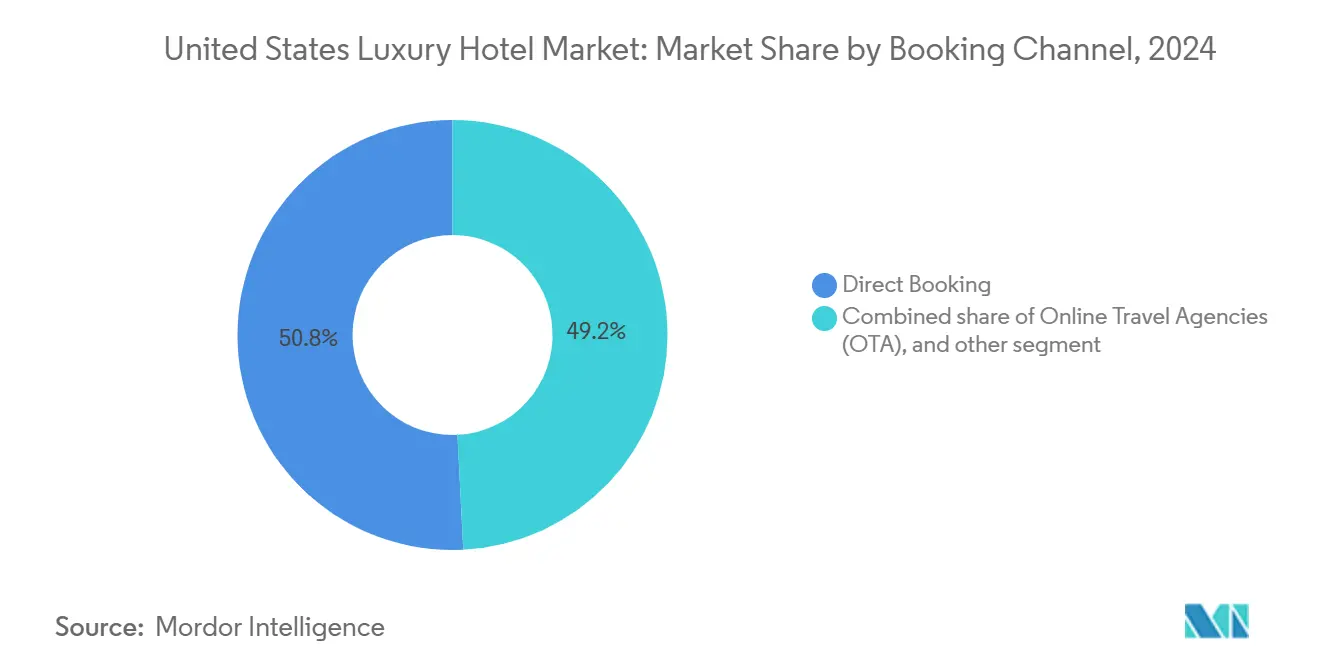
Note: Segment shares of all individual segments available upon report purchase
By Service Type: Resorts Maintain Experiential Leadership
Resorts led with a 36.26% share of 2024 revenue, confirming travelers’ appetite for immersive, multi-day experiences that bundle accommodation with recreation, wellness, and culinary discovery. Suite hotels deliver the fastest expansion, posting an 8.24% CAGR to 2030 as remote work trends blur traditional stay categorizations. Business hotels secure 29% share through their proximity to financial districts and convention venues, underpinning weekday occupancy in urban cores. Airport luxury properties comprise 10%, offering premium transit solutions for international executives and family groups alike. Operators increasingly infuse resorts with local storytelling, farm-to-table gastronomy, and regenerative spa programs to sustain rate premiums. Suite hotels, by contrast, focus on apartment-style flexibility, in-room fitness, and Zoom-ready lighting, aligning with hybrid work expectations. This nuanced service mix enriches the revenue architecture of the United States luxury hotel market.
Geography Analysis
The South retained 31.74% of 2024 revenue, bolstered by Florida’s year-round leisure inflow, Texas’s corporate campus expansion, and a tax-friendly climate attractive to affluent snowbird segments. Consistent air connectivity and diversified economic drivers shield the region from seasonality shocks. Meanwhile, the West is set to grow at a 7.87% CAGR, powered by technology wealth in California and Washington, gateway traffic in Los Angeles and San Francisco, and lifestyle migration into mountain sub-markets. High ADRs in Napa, Aspen, and Maui magnify revenue momentum, even amid supply constraints and wildfire-driven insurance volatility.
The Northeast maintains 28% share as New York, Boston, and Philadelphia reinforce their status as financial, academic, and cultural magnets. Manhattan’s ADR surpassed 2019 levels by more than 20% in 2023, illustrating the metropolis’s enduring pricing leverage despite corporate occupancy lags. Historic properties and branded residences support mixed-use revenue streams that steady cash flows across cycles. The Midwest, with 8% share, posts steady growth anchored by Fortune 500 headquarters in Chicago, Minneapolis, and Columbus. Convention center expansions and diversified sports calendars draw both transient and group demand, albeit at lower ADR baselines than coastal counterparts.
Climate-related insurance hikes averaging 40% since 2019 continue to weigh on coastal projects, nudging some investors toward inland Sunbelt metros where risk-adjusted returns appear more favorable. Nonetheless, international gateway positioning and cultural cachet sustain investor interest in major coastal markets, preserving their strategic significance within the United States luxury hotel market.
Competitive Landscape
The United States luxury hotel market is moderately consolidated, with the top five brands capturing a significant share of 2024 revenue. Marriott International leads with flagship luxury brands like Ritz-Carlton, St. Regis, and Edition, while Hilton secures a strong position through Waldorf Astoria and Conrad. Hyatt’s 2024 acquisition of Standard International signals a strategic push into lifestyle brands that appeal to younger, affluent travelers. Accor and LVMH’s revival of Orient Express highlights the growing synergy between luxury retail and hospitality, emphasizing heritage and exclusivity. Despite their fragmented presence, independent operators thrive through hyper-local experiences, distinctive design, and personalized service rituals.
ESG is becoming a key market driver, with LEED-certified hotels showing both revenue premiums and post-certification resilience. This is pushing operators to invest in green retrofits and build more sustainable supply chains. Technology adoption continues to rise, with AI-driven personalization and robotic housekeeping addressing labor shortages and improving guest satisfaction. These innovations are especially crucial as operators look to manage costs while elevating service standards. As sustainability and tech converge, ESG-aligned properties are gaining a competitive edge.
Private equity interest remains strong, particularly in mixed-use models where residential components help subsidize hotel development. These structures reduce risk and attract investors seeking long-term value. The U.S. luxury hotel market increasingly rewards scale in loyalty programs and distribution networks, while still recognizing the value of boutique authenticity. Operators that can balance operational efficiency with experiential uniqueness are best positioned for growth. Overall, leadership in the market will depend on harmonizing brand strength, sustainability, and innovation.
United States Luxury Hotel Industry Leaders
-
Marriott International
-
Hilton Worldwide
-
Hyatt Hotels Corp.
-
Four Seasons Hotels & Resorts
-
Accor SA
- *Disclaimer: Major Players sorted in no particular order
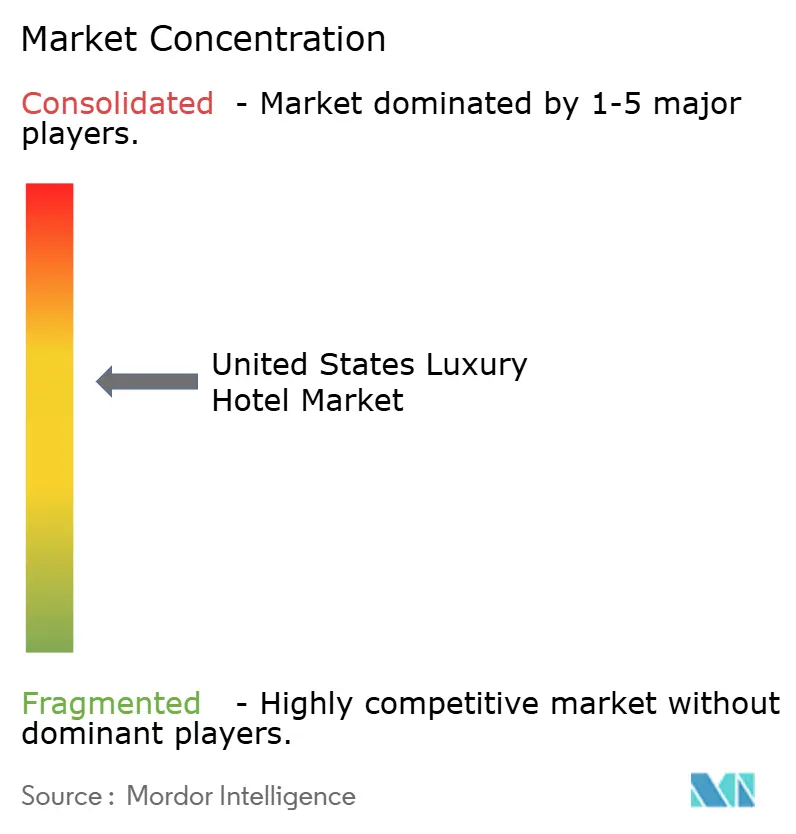


Recent Industry Developments
- April 2025: Grand Metropolitan Hotels secured Voile d'Or’s brand and IP, with expansion plans for the Maldives and Dubai alongside New York and Paris renovations.
- January 2025: Accor announced nearly 90 new luxury openings for 2024, including 32 Sofitel properties and extensive renovations across its upper-upscale portfolio.
- August 2024: Hyatt Hotels Corporation finalized its acquisition of Standard International for USD 150–335 million, adding 21 lifestyle hotels to the World of Hyatt program.
- August 2024: Host Hotels & Resorts acquired the 234-room 1 Hotel Central Park for USD 265 million, reflecting an 11.1× EBITDA multiple and positioning the asset among Host’s top-10 performers.
United States Luxury Hotel Market Report Scope
A luxury hotel provides a premium lodging experience, catering predominantly to affluent clientele with a focus on top-tier services and gourmet dining.
The US luxury hotel market is segmented by service type (business hotel, airport hotel, suite hotel, resort and spa, and other service types) and theme (heritage, contemporary, modern, and other themes). The report offers market sizes and forecasts in terms of value (USD) for all the above segments.
| Standard Luxury Room |
| Suites |
| Villas / Bungalows |
| Penthouses & Presidential Suites |
| Direct Booking (Brand Website, Call Center) |
| Online Travel Agencies (OTA) |
| Travel Agents / Tour Operators |
| Corporate Contracts |
| Business Hotels |
| Airport Hotels |
| Suite Hotels |
| Resorts |
| Other Service Types |
| Northeast |
| Midwest |
| South |
| West |
| By Room Type | Standard Luxury Room |
| Suites | |
| Villas / Bungalows | |
| Penthouses & Presidential Suites | |
| By Booking Channel | Direct Booking (Brand Website, Call Center) |
| Online Travel Agencies (OTA) | |
| Travel Agents / Tour Operators | |
| Corporate Contracts | |
| By Service Type | Business Hotels |
| Airport Hotels | |
| Suite Hotels | |
| Resorts | |
| Other Service Types | |
| By Geography | Northeast |
| Midwest | |
| South | |
| West |


Key Questions Answered in the Report
How large is the United States luxury hotel market in 2025?
The United States luxury hotel market size is USD 42.75 billion in 2025, with a forecast value of USD 62.22 billion by 2030.
What is the expected growth rate for premium hotel suites?
Villas / Bungalows are expanding in the United States luxury hotel market at a 7.88% CAGR through 2030, supported by extended-stay demand.
Which region is growing fastest for upscale hotels?
The West is the fastest-growing territory, advancing at a 7.87% CAGR as technology wealth and international gateways drive luxury demand.
How are direct bookings affecting profitability?
Direct Booking now exceed 50% of transactions and cut 15–25% commission costs, producing higher net RevPAR for operators.
What is the industry’s biggest operational challenge?
Persistent labor shortages, with 79% of hotels reporting vacancies, elevate payroll expenses and pressure service delivery standards.
Page last updated on:
